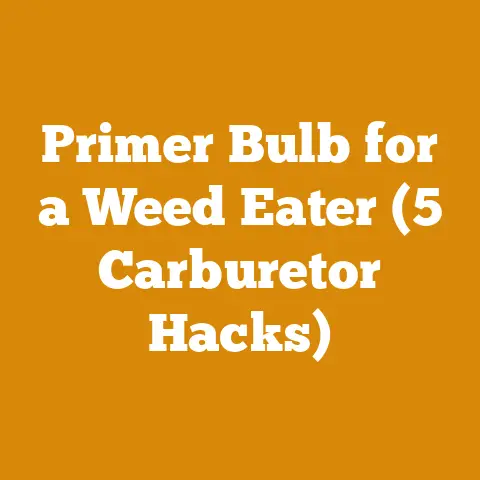Clean Soot Off Vinyl Siding (5 Pro Tips for Firewood Users)
Must-Have for Firewood Users: How to Banish Soot from Your Vinyl Siding!
Have you ever admired a cozy fire, only to later cringe at the sight of your house’s vinyl siding covered in unsightly soot? I know I have. As someone who heats their home primarily with wood, I’ve battled this grimy nemesis more times than I care to admit. But don’t despair! Over the years, I’ve honed my soot-removal skills, and I’m here to share my top 5 pro tips for keeping your vinyl siding sparkling clean, even if you’re a dedicated firewood user.
Key Takeaways:
- Prevention is Key: Understand how firewood choices and burning practices impact soot production.
- Gentle Cleaning is Essential: Harsh chemicals and abrasive methods can damage vinyl siding.
- The Right Tools Matter: Using the correct brushes, cleaners, and equipment makes a huge difference.
- Timing is Everything: Cleaning soot promptly prevents it from becoming ingrained.
- Safety First: Protect yourself and your property during the cleaning process.
Let’s dive in and get that soot gone!
The Soot Situation: Why Firewood Users Face This Challenge
Before we get to the cleaning, it’s crucial to understand why firewood users are particularly susceptible to soot buildup on their vinyl siding. It’s not just about burning wood; it’s about the way we burn it and the type of wood we use.
The Science of Soot: A Firewood User’s Primer
Soot, at its core, is unburned carbon particles. It’s a byproduct of incomplete combustion, meaning the wood isn’t burning as efficiently as it could be. Several factors contribute to this:
- Wood Moisture Content: This is the big one. Green or unseasoned wood contains a lot of water. When you burn it, energy is wasted boiling off that water instead of producing heat. This leads to a cooler fire, incomplete combustion, and more soot. Studies show that burning wood with a moisture content above 20% can increase particulate matter emissions (including soot) by as much as 500% compared to properly seasoned wood.
- Wood Type: Softwoods like pine tend to produce more soot and creosote than hardwoods like oak or maple, especially if they aren’t fully seasoned. This is due to their higher resin content.
- Burning Practices: Smoldering fires, where the wood is starved of oxygen, are soot factories. Always aim for a hot, bright fire with plenty of airflow.
- Chimney Condition: A dirty or poorly maintained chimney can restrict airflow, leading to incomplete combustion and increased soot production.
My Soot Story: A Lesson Learned the Hard Way
I remember one particularly cold winter when I was running low on seasoned oak. In desperation, I started burning some pine that I thought was dry enough. Big mistake! Within weeks, my once-pristine white vinyl siding was sporting a rather unattractive gray hue. It was a wake-up call. I realized I needed to be much more diligent about wood selection, seasoning, and burning practices.
By focusing on prevention, you can significantly reduce the amount of soot that ends up on your vinyl siding in the first place.
The Importance of Seasoned Firewood: Your First Line of Defense
I can’t stress this enough: use only seasoned firewood. Seasoning involves drying the wood for a sufficient period to reduce its moisture content.
- How to Season Firewood: Stack your firewood off the ground in a sunny, well-ventilated area. Allow air to circulate freely around the stack. Cover the top of the stack to protect it from rain and snow, but leave the sides open for airflow.
- How Long to Season: Hardwoods generally require 6-12 months of seasoning, while softwoods may only need 3-6 months.
- How to Tell if Firewood is Seasoned: Seasoned wood will be lighter in weight than green wood. It will also have cracks and splits on the ends. When you strike two pieces together, they should make a hollow sound rather than a dull thud. A moisture meter is a great investment to accurately measure moisture content; aim for below 20%.
Choosing the Right Wood: Hardwood vs. Softwood
While I sometimes burn softwoods, I always prioritize hardwoods. Hardwoods burn hotter, longer, and cleaner than softwoods.
- Best Hardwoods for Firewood: Oak, maple, ash, birch, and beech are excellent choices.
- Softwoods to Use with Caution: Pine, fir, and spruce can be burned, but use them sparingly and ensure they are well-seasoned.
- A Note on Creosote: Burning softwoods can lead to increased creosote buildup in your chimney, which is a fire hazard. Regular chimney cleaning is essential if you burn softwoods frequently. According to the Chimney Safety Institute of America (CSIA), you should have your chimney inspected annually and cleaned as needed.
Burning Practices: Optimizing for Clean Combustion
How you burn your firewood matters just as much as the type of wood you use.
- Start with Kindling: Use small, dry pieces of kindling to get the fire going quickly and efficiently.
- Top-Down Burning: Consider using a top-down burning method, where you stack the larger pieces of wood on the bottom and the kindling on top. This can help to reduce smoke and soot.
- Airflow is Key: Ensure your fire has plenty of airflow. Adjust the air vents on your wood stove or fireplace to maintain a hot, bright flame.
- Avoid Smoldering Fires: Never let your fire smolder for extended periods. This produces a lot of smoke and soot.
- Regular Chimney Maintenance: Schedule annual chimney inspections and cleanings to remove creosote and ensure proper airflow.
Pro Tip #2: Gentle is the Word – Choosing the Right Cleaning Solutions
Vinyl siding is durable, but it can be damaged by harsh chemicals and abrasive cleaning methods.
The Dangers of Harsh Chemicals: Protecting Your Vinyl
Avoid using harsh chemicals like bleach, ammonia, or strong solvents on your vinyl siding. These can discolor, warp, or even melt the vinyl.
- Bleach Alternatives: While bleach is sometimes recommended for cleaning vinyl siding, I prefer to avoid it due to its potential to damage the siding and harm the environment. If you do use bleach, dilute it heavily with water and test it in an inconspicuous area first.
- The pH Factor: Look for cleaning solutions with a neutral pH. Highly acidic or alkaline cleaners can damage vinyl siding.
My Go-To Cleaning Solutions: Tried and Tested
Over the years, I’ve experimented with various cleaning solutions, and I’ve found a few that work exceptionally well for removing soot from vinyl siding without causing damage.
- Dish Soap and Water: This is my go-to solution for light soot buildup. Mix a few drops of dish soap with a gallon of warm water.
- Vinegar and Water: Vinegar is a natural cleaner and deodorizer. Mix equal parts white vinegar and water.
- Commercial Vinyl Siding Cleaners: There are many commercial vinyl siding cleaners available on the market. Choose one that is specifically designed for vinyl siding and follow the manufacturer’s instructions carefully. I’ve had good results with brands like Simple Green and Krud Kutter.
Recipe for Success: My Favorite DIY Soot Remover
Here’s my favorite DIY soot remover recipe:
- 1 gallon warm water
- 1/4 cup dish soap (I prefer Dawn)
- 1/2 cup white vinegar
- 1/4 cup baking soda
Mix all ingredients in a bucket. The baking soda will fizz initially, so mix slowly. This solution is effective for removing light to moderate soot buildup.
Using the wrong tools can damage the siding or make the job much more difficult.
The Power of Soft Brushes: Avoiding Scratches
Never use abrasive scrub brushes or scouring pads on vinyl siding. These can scratch the surface and make it more susceptible to dirt and grime.
- Soft-Bristled Brushes: Use a soft-bristled brush, such as a car wash brush or a siding brush, to gently scrub the siding.
- Microfiber Cloths: Microfiber cloths are excellent for wiping down the siding after cleaning. They are soft, absorbent, and won’t scratch the surface.
- Extendable Handles: Consider using a brush with an extendable handle to reach high areas without having to climb a ladder.
Pressure Washers: Use with Extreme Caution
Pressure washers can be effective for cleaning vinyl siding, but they can also cause damage if used improperly.
- Low Pressure is Key: Use a low-pressure setting (below 1500 PSI) and a wide fan nozzle.
- Maintain Distance: Keep the nozzle at least 2-3 feet away from the siding.
- Spray at an Angle: Spray the siding at an angle to avoid forcing water behind the siding.
- Test in an Inconspicuous Area: Always test the pressure washer in an inconspicuous area before cleaning the entire house.
Expert Insight: “Pressure washing vinyl siding is like performing surgery with a chainsaw,” says Bob Vila, home improvement expert. “It can be effective, but it’s easy to cause serious damage if you’re not careful.”
My Tool Arsenal: The Essentials
Here’s a list of the tools I keep on hand for cleaning soot off my vinyl siding:
- Buckets
- Soft-bristled brush with extendable handle
- Microfiber cloths
- Garden hose with spray nozzle
- Pressure washer (used with extreme caution)
- Ladder (for reaching high areas)
- Safety glasses
- Gloves
Pro Tip #4: Timing is of the Essence – Don’t Let Soot Set In
The longer soot sits on your vinyl siding, the harder it will be to remove. Cleaning soot promptly prevents it from becoming ingrained and causing permanent staining.
The Window of Opportunity: Strike While the Soot is Fresh
Ideally, you should clean your vinyl siding at least once a year, or more often if you notice significant soot buildup.
- Spring Cleaning: Spring is a great time to clean your vinyl siding after a long winter of burning firewood.
- Fall Preparation: Cleaning your siding in the fall can help to prevent soot from becoming ingrained over the winter.
- Spot Cleaning: Address small areas of soot buildup as soon as you notice them.
Weather Considerations: The Ideal Cleaning Day
Choose a mild, cloudy day to clean your vinyl siding. Avoid cleaning in direct sunlight, as the cleaning solution can dry too quickly and leave streaks.
- Temperature Range: The ideal temperature range for cleaning vinyl siding is between 50°F and 70°F.
- Avoid Extreme Heat or Cold: Avoid cleaning in extreme heat or cold, as the cleaning solution may not work effectively.
My Cleaning Schedule: A Proactive Approach
I try to clean my vinyl siding at least twice a year – once in the spring and once in the fall. I also do spot cleaning as needed throughout the year. This proactive approach helps to keep my siding looking its best and prevents soot from becoming a major problem.
Pro Tip #5: Safety First – Protecting Yourself and Your Property
Cleaning soot off vinyl siding can be a messy and potentially hazardous job. It’s important to take precautions to protect yourself and your property.
Personal Protective Equipment: Gear Up for the Job
Always wear appropriate personal protective equipment (PPE) when cleaning vinyl siding.
- Safety Glasses: Protect your eyes from splashes and debris.
- Gloves: Protect your hands from cleaning solutions and dirt.
- Long Sleeves and Pants: Protect your skin from cleaning solutions and the sun.
- Closed-Toe Shoes: Protect your feet from slips and falls.
Ladder Safety: A Must-Know
If you need to use a ladder to reach high areas, follow these safety tips:
- Choose the Right Ladder: Use a ladder that is tall enough to reach the area you need to clean without overextending.
- Inspect the Ladder: Inspect the ladder for damage before each use.
- Set Up the Ladder Properly: Place the ladder on a firm, level surface. Ensure the ladder is at a safe angle (about 75 degrees).
- Never Overreach: Never overreach while on a ladder. Move the ladder as needed.
- Have a Spotter: If possible, have someone spot you while you are on the ladder.
Protecting Your Plants and Landscaping: A Thoughtful Approach
Cleaning solutions can harm plants and landscaping. Take precautions to protect them.
- Wet Down Plants: Wet down the plants around the area you are cleaning before you start. This will help to protect them from the cleaning solution.
- Cover Plants: Cover delicate plants with plastic sheeting.
- Rinse Thoroughly: Rinse the plants thoroughly after cleaning.
My Safety Checklist: A Pre-Cleaning Routine
Before I start cleaning my vinyl siding, I always run through this safety checklist:
- Wear safety glasses, gloves, and appropriate clothing.
- Inspect the ladder for damage.
- Set up the ladder properly on a firm, level surface.
- Wet down or cover plants and landscaping.
- Ensure there are no electrical hazards in the area.
- Inform family members or neighbors that I will be cleaning the siding.
Conclusion: A Sparkling Clean Future
Cleaning soot off vinyl siding doesn’t have to be a daunting task. By following these 5 pro tips, you can keep your siding looking its best and enjoy your cozy fires without worrying about unsightly soot buildup. Remember, prevention is key, gentleness is essential, the right tools matter, timing is everything, and safety always comes first.
Now, it’s your turn! Grab your cleaning supplies, choose a mild day, and get ready to transform your vinyl siding from soot-covered to sparkling clean. And don’t forget to share your results and any additional tips you discover along the way. Happy cleaning!






